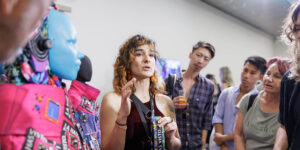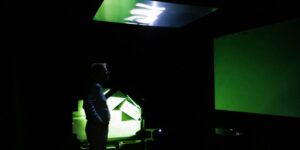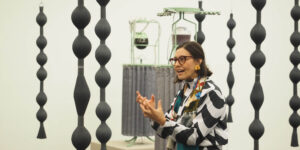cifo

Have You Seen Her...?
Dora Ytzell Bartilotti (MX)
Participatory art piece that seeks to generate a poetic gesture of search and collective demand to make present our missing women, victims of forced disappearance in Mexico. The project seeks to bring together a polyphony of voices around the question “La has visto...?” (“Have you seen her?”) through a sound sculpture and a series of fabric strips. Each strip corresponds to a missing identity, to each of them the question: “La has visto?”

int.: time slip, a song for structural comfort
Thessia Machado (BR/US)
A sound and light installation, featuring two wall-mounted, light-sensitive string instruments played by a video projection. The architecture itself functions as the resonating body, singing through its structure and filling the space with a composition of evolving drones.

The Walls Know
Ana Elena Tejera (PA)
The old School of the Americas in Panama still stands: a three-story building, long corridors and few people. The halls witnessed a rigorous military education founded on oppressed soldiers of Latin American dictators and leaders. Today these same walls enclose a hotel, and the terrifying past is still present. The immersive installation is an artificial intelligence performance grounded on military manuals, archival images, what lies behind the sensations and memories and remnants of the place.

Cenizas del Paraná
Gabriela Munguía (MX), Guadalupe Chávez (MX)
Cenizas del Paraná is a tactical and speculative research into the Paraná wetlands. Embracing the resilient forces of vegetal and rhizospheric communities endangered by local wildfires and global climate change, this sound art and transmedia project encompasses a collaborative network nourished by environmental associations, local activists, artists, biologists and communities that fight for the conservation, protection and sustainable use of the Paraná wetlands.

Chimera, Expanded Bodies
Amor Muñoz (MX)
Chimera, Expanded Bodies is a biotechnological poetic installation in which a series of bio-automatons generate performative gestures through a biological process and a textile nervous system activated by the public.

